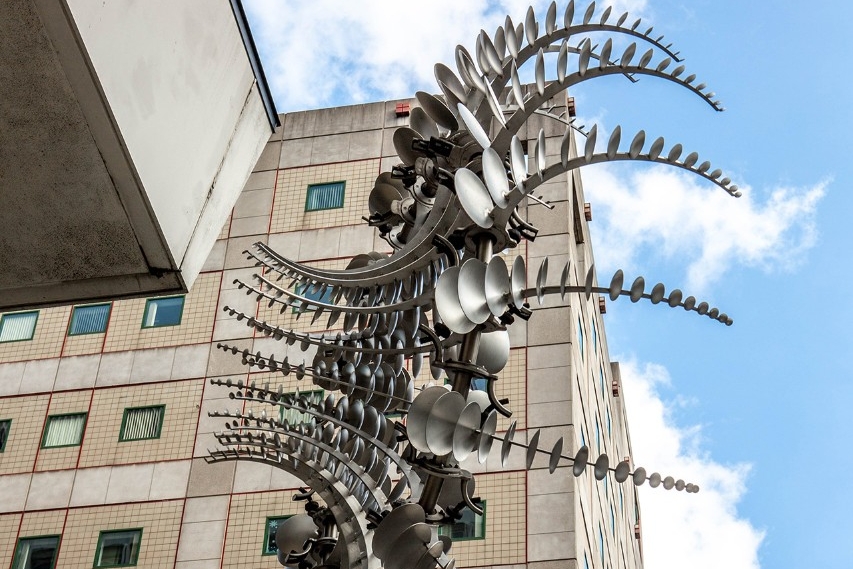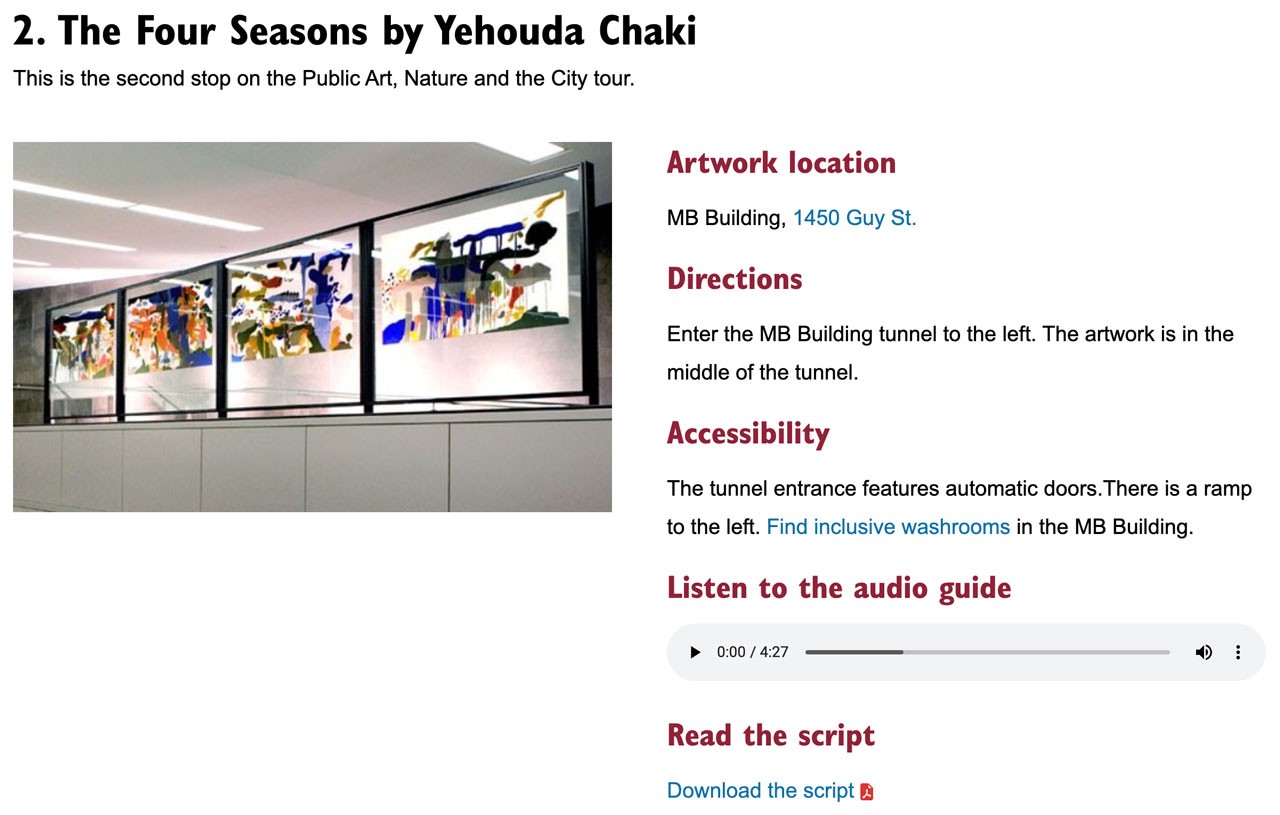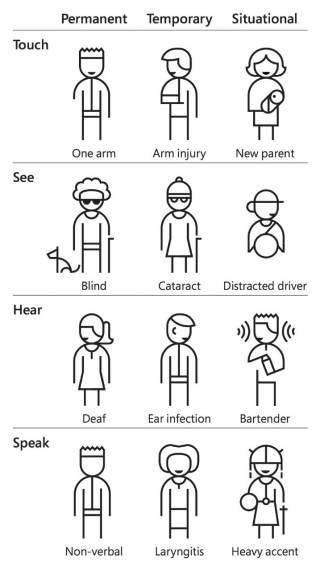Circumstances impact our ability to process information and can affect how we use technology— be it with voice commands, gestures, keyboard and more. What kinds of circumstances? Have you ever tried opening a door when your hands are full? Or read a video’s captions because your environment was too noisy to hear it? For some these circumstances are temporary, or situational, while others may depend on accessibility technologies to get an equitable experience: Someone with limited motor skills might use a keyboard to navigate instead of a mouse, or a person with low vision might enlarge their screen. We need to ensure that our web content is accessible for all.
article
Public Art walking tours and its holistic approach to accessibility

As digital communications experts we want to create accessible web pages. While accessibility is a legal requirement for us, we want our web content to be equally available to everyone; it aligns with Concordia’s values of inclusion and belonging. We consider web accessibility every day in our work. But we often overlook accessibility in our physical spaces.
Public art audio tours
Public Art created three self-guided tours featuring 19 of Concordia’s public art installations on the downtown campus, each of which was presented on the Public Art subsite. Each tour features a custom Google map, and each artwork had its own:
- audio guide
- downloadable transcript
- a high-quality image
- alternative text description of the image for screen readers
Although the web content was accessible, further work was needed to create a more truly inclusive and accessible experience.
Public Art Lead, Sandra Margolian, wanted to ensure that the tours were physically accessible. She explains that her previous work in Concordia’s Office of Community Engagement has guided her towards a greater sensitivity about accessibility in general. In 2021, when she ran community consultations on the future of Public Art at Concordia, the respondents rated accessibility as “important” for both future installations and programming. This sensitivity and feedback informed Concordia’s public art policy [PDF] that was announced in late 2023.
Margolian consulted with Anna Barrafato, Concordia’s Accessibility change lead. The two of them walked through the routes, and their findings are reflected in the web text as Accessibility notes. Each artwork’s description includes an accessibility sub-section, which indicates automatic doors, proximity to seating and inclusive washrooms.
These notes help empower individuals who rely on accessibility features in the physical environment to know what to expect when following a tour: not just elevators and wheelchair ramps, but the presence of automatic doors, the location of inclusive washrooms, available seating and alternate paths to an artwork. Ensuring physical accessibility means a wheelchair user, a person recovering from an injury, or a parent pushing a stroller will all be able to visit that space independently, without worry or unpleasant surprises.
 Screen capture of an artwork featured on one of Concordia's Public Art tours. Each artwork includes accessibility notes, audio guide and downloadable transcript.
Screen capture of an artwork featured on one of Concordia's Public Art tours. Each artwork includes accessibility notes, audio guide and downloadable transcript.
Accessibility and design of digital content
We always follow the rule of “content dictates design.” We first determined the content we would need for each tour (and individual works). Once we determined those elements – discovered through an iterative process – we built the pages using our checklist:
- Title of tour
- Introductory text describing the tour
- Map showing the locations of the artworks on the tour
- Text details about the tour, including the anticipated duration in minutes
- List of works on the tour which include:
- Name and artist
- High-quality image of the artwork
- Location
- Directions
- Accessibility notes
- Audio guide
- Downloadable transcript (pdf)
- Link to the artist details page
Screen readers can handle text-based elements, but a web page must follow a hierarchical heading structure for the technology to offer an optimal experience. While we can skip the alt-text for decorative images, omitting it for the blind or visually impaired would offer a lacklustre experience.
Lessons and next steps
The final web pages describe self-guided tours that offer an accessible experience for everyone, in both its physical and web (digital) aspects. There’s a foundational tenet in User Experience (UX) design that good UX helps everyone: clear steps, clear call-to-actions and carefully organized content means a web visitor can interact with a website or app and accomplish a task with ease. The same holds true for our physical spaces, so taking time to consult with an accessibility expert will improve the visitor’s experience. Margolian notes, “I learned about the importance of consulting with someone like Anna, as I am not a specialist in this area. That [accessibility] language is also constantly evolving.”
Although we put great efforts to ensure our pages are accessible, we sometimes find errors. We tested the tour pages with the WAVE tool — a Chrome plug-in that checks a web page’s accessibility features — and uncovered some errors with our custom Google maps. A little digging revealed our error was already a known issue in the development community. While our map may not be 100%, triple-A accessible, the building’s addresses are included as text elements that screen readers can manage.
In large institutions, it’s easy to overlook accessibility, but a small investment of time with an accessibility expert will bring a better user experience for everyone.
This project was realized by:
- Sandra Margolian: Public Art Lead
- Sarah Sookman: Digital Content Advisor
- Diane Leyland: Web/UI Designer
- Carl Summers: Junior Front-end Developer
The scripts were written by Elliott Elliott (MFA 20) and Max Holzberg (BFA 21).
Reach out to websupport@concordia.ca if you would like tips to improve the accessibility of your web content.
